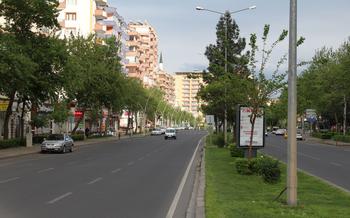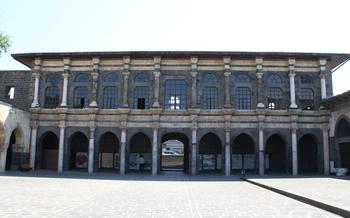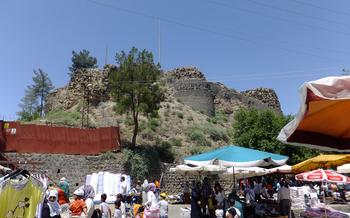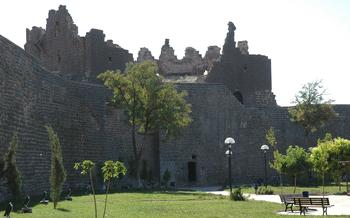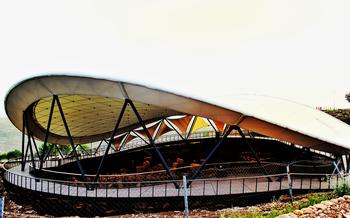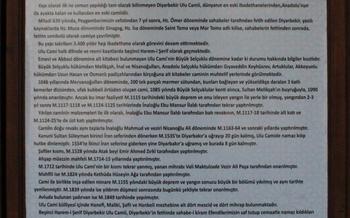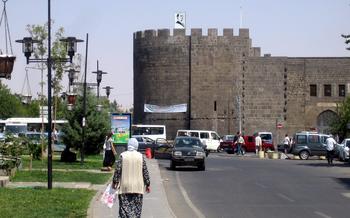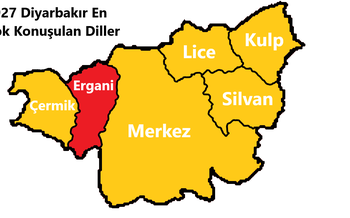
Urfa Gate
- Urfa Gate: A Journey Through History
- Architectural Features
- Location and Access
- Exploring the Gate
- Surrounding Area
- Interactive Exhibits
- Preservation Efforts
- Local Legends
- Festivals and Events
- Art and Architecture
- Historical Figures
- Photography Opportunities
- Local Cuisine
- Insider Tip:
Urfa Gate: A Journey Through History
The Urfa Gate, an architectural masterpiece nestled in the heart of Diyarbakır, Turkey, holds an unparalleled legacy that spans centuries. Its story begins in the Roman Empire, when the city was known as Amid. The Romans erected the gate as part of their formidable defense system, recognizing its strategic significance. Over time, the gate has undergone various modifications and embellishments, reflecting the diverse civilizations that have left their mark on Diyarbakır.
During the Islamic era, the gate gained prominence as a crucial entrance to the city. Its imposing structure and sturdy fortifications served as a testament to Diyarbakır's resilience and fortitude. The gate withstood numerous sieges and battles, becoming a symbol of the city's unwavering spirit. Throughout history, the Urfa Gate has witnessed countless events, from triumphant victories to heart-wrenching defeats, solidifying its place as an enduring sentinel of Diyarbakır's rich past.
Intricate carvings and inscriptions adorn the gate's surface, narrating tales of bygone eras. These artistic embellishments showcase the blending of different cultural influences, creating a unique architectural tapestry. Legends and folklore intertwine with historical facts, adding layers of mystique and enchantment to the gate's allure.
As you step through the Urfa Gate, you embark on a journey through time, transported to an era where history echoes in every stone and whispers in every breeze. This architectural marvel stands as a testament to Diyarbakır's enduring legacy, a symbol of its resilience and a reminder of its pivotal role in shaping the region's destiny.
Architectural Features
The Urfa Gate, a majestic testament to the city's enduring legacy, stands as one of the most impressive historical gates in Turkey. Its grand size and imposing structure immediately captivate visitors, hinting at the rich history it holds within. Unique architectural elements, such as the pointed arches and intricate carvings, add to its allure, making it a visual masterpiece.
Constructed using robust basalt and limestone, the gate's construction materials reflect the resilience and durability of Diyarbakır's spirit. The pointed arches, a characteristic feature of Islamic architecture, lend a sense of grandeur and elegance to the structure. The intricate carvings, depicting various motifs and patterns, showcase the exceptional craftsmanship and attention to detail of the ancient builders.
Comparing the Urfa Gate to other historical gates in Turkey reveals its distinct architectural style. While it shares similarities with the gates of Istanbul, such as the Topkapi Gate and the Yedikule Gate, the Urfa Gate possesses a unique charm that sets it apart. Its combination of Islamic and local influences creates a harmonious blend that reflects the diverse cultural heritage of Diyarbakır.
Location and Access
The Urfa Gate stands tall in the heart of Diyarbakır's ancient city center, serving as a gateway to its rich history and cultural tapestry. Reaching the gate is a breeze, whether you choose to stroll through the city's vibrant streets or hop on public transportation.
From Diyarbakır Airport, you can take a taxi or ride the public bus to the city center. The gate is just a short walk from popular landmarks like the Grand Mosque of Diyarbakır and the Diyarbakır Castle. For those with limited mobility, the gate is wheelchair accessible, ensuring everyone can marvel at its grandeur.
In the vicinity of the gate, you'll find a treasure trove of hidden gems waiting to be discovered. Explore the labyrinthine streets of the old city, where charming shops and aromatic eateries line the way. Immerse yourself in the local culture by interacting with friendly locals, who are always eager to share stories and insights about their beloved city.
Exploring the Gate
Stepping through the Urfa Gate is like stepping back in time, transporting you to the heart of Diyarbakır's rich history. As you wander through the gate's imposing archway, take a moment to admire the intricate carvings and inscriptions that adorn its surface, telling tales of past rulers and conquests.
Keep an eye out for the worn cobblestones beneath your feet, each one a silent witness to the countless travelers who have passed through this gateway over the centuries. As you emerge into the bustling streets of the old city, let the vibrant energy and sounds envelop you.
Don't miss the opportunity to capture the perfect photo of this iconic landmark. Whether you're an amateur photographer or a seasoned pro, the Urfa Gate offers endless angles and perspectives to showcase its grandeur. For the best lighting, visit during the golden hour, when the setting sun casts a warm glow on the gate's ancient stones.
Surrounding Area
Stepping through the Urfa Gate is like stepping back in time, as the vibrant streets of the old city unfold before you. These narrow, winding streets are lined with an array of shops and restaurants, each offering a glimpse into the local culture. From traditional Turkish handicrafts to delectable street food, the old city is a treasure trove of hidden gems.
One of the most prominent landmarks near the Urfa Gate is the Great Mosque of Diyarbakır, a stunning example of Islamic architecture dating back to the 11th century. With its intricate carvings and towering minarets, the mosque is a testament to the city's rich history and architectural heritage.
For a panoramic view of Diyarbakır, climb to the top of the Diyarbakır Castle, situated on a hill overlooking the city. The castle, built by the Romans in the 4th century, offers breathtaking views of the surrounding landscape, including the meandering Tigris River.
To truly immerse yourself in the local culture, take the time to interact with the friendly residents of Diyarbakır. Whether it's chatting with shopkeepers, bargaining for souvenirs, or simply sipping Turkish coffee at a local café, these interactions will provide a deeper understanding of the city's unique way of life.
Last but not least, don't forget to sample the delicious local cuisine. Diyarbakır is renowned for its flavorful dishes, such as the spicy Mırra soup, stuffed grape leaves, and the melt-in-your-mouth künefe dessert. With its diverse culinary offerings, Diyarbakır is a foodie's paradise waiting to be explored.
Interactive Exhibits
While exploring the Urfa Gate, visitors can enhance their experience by engaging with the interactive exhibits located within and near the gate. These exhibits employ innovative technologies and creative displays to bring history to life and make learning fun and interactive.
Touchscreens and digital kiosks provide in-depth information about the gate's construction, historical significance, and the various civilizations that have influenced its design. Visitors can explore interactive maps, view historical images, and learn about the gate's role in different periods of Diyarbakır's history.
Immersive historical reenactments and virtual reality experiences transport visitors back in time, allowing them to witness significant events and experience the gate's grandeur as it once stood. These interactive elements engage visitors of all ages, making the Urfa Gate not just a historical landmark but also an educational and entertaining destination.
Preservation Efforts
The Urfa Gate, a testament to Diyarbakır's rich history, has undergone several restoration and conservation projects to preserve its grandeur for future generations. These efforts aim to protect the gate's architectural integrity and historical significance while ensuring its safety and accessibility for visitors.
One of the most significant preservation projects was undertaken in the early 2000s, focusing on structural reinforcement and restoration of the gate's intricate carvings. Skilled artisans meticulously repaired damaged sections, using traditional techniques and materials to maintain the gate's authenticity. This extensive project helped to stabilize the structure and prevent further deterioration.
Preserving historical landmarks like the Urfa Gate poses several challenges. The gate's age, exposure to harsh weather conditions, and the impact of human interaction require ongoing maintenance and careful monitoring. Balancing the need for conservation with the desire to maintain the gate's original character can be a delicate task.
Local communities and international organizations play a vital role in preserving cultural heritage sites like the Urfa Gate. Through collaborations, fundraising initiatives, and awareness campaigns, they provide essential support for restoration projects and promote the importance of safeguarding historical treasures.
The preservation of the Urfa Gate is not merely about protecting a physical structure but also about preserving the cultural identity and heritage of Diyarbakır. By investing in conservation efforts, we ensure that future generations can continue to appreciate and learn from this architectural marvel, which stands as a symbol of the city's rich and diverse past.
Local Legends
The Urfa Gate is entwined with a rich tapestry of local legends that have shaped its significance in the cultural fabric of Diyarbakır. One captivating tale narrates the story of a young maiden named Urfa who resided in the city during ancient times. Urfa possessed an extraordinary ability to foresee the future, and her visions often guided the people of Diyarbakır in times of uncertainty.
As the city faced imminent danger, Urfa stood atop the gate, her eyes fixed upon the horizon. She perceived an impending invasion by a formidable army, and her heart sank with dread. Determined to protect her beloved city, Urfa used her gift to devise a cunning strategy. She instructed the townspeople to fill large pots with boiling water and oil and position them strategically along the city walls.
When the enemy forces arrived at the gate, eager to breach the city's defenses, they were met with a scorching surprise. Urfa, standing tall and resolute, poured the boiling liquid onto the invaders, repelling their attack and saving Diyarbakır from imminent destruction.
This heroic act cemented Urfa's status as a legendary figure in Diyarbakır's history. Her bravery and selflessness are recounted through generations, and the Urfa Gate stands as a testament to her enduring legacy, a symbol of courage and resilience that continues to inspire the people of Diyarbakır to this day.
Festivals and Events
The Urfa Gate, a historic landmark in Diyarbakır, comes alive during special events and festivals that showcase the city's rich cultural heritage. One of the most notable events is the Diyarbakır Culture and Art Festival, held annually in May. This vibrant festival features traditional music performances, art exhibitions, and colorful parades that fill the streets surrounding the gate. Visitors can immerse themselves in the lively atmosphere as local artisans display their handmade crafts, and street vendors offer delicious local delicacies. The festival is a fantastic opportunity to experience the vibrant spirit of Diyarbakır and learn about its diverse cultural traditions.
Art and Architecture
The Urfa Gate, a masterpiece of Islamic architecture, stands as a testament to the artistic and architectural prowess of its creators. Its design seamlessly blends elements of various civilizations, reflecting Diyarbakır's rich cultural heritage. The gate's imposing structure and intricate carvings showcase the skill and craftsmanship of ancient artisans. Its pointed arches, geometric patterns, and Quranic inscriptions add to its aesthetic appeal, making it a visual delight for visitors. Comparing the Urfa Gate to other historical gates in Turkey reveals the unique architectural style that distinguishes it. While sharing similarities in terms of functionality and defensive purposes, the Urfa Gate's artistic details set it apart, highlighting the region's distinctive artistic traditions.
Historical Figures
Throughout history, the Urfa Gate has witnessed the footsteps of many notable historical figures who played a significant role in shaping its story. One such figure is the legendary Kurdish warrior, Sheikh Said Piran. In 1925, Sheikh Said led a rebellion against the Turkish government, using the Urfa Gate as a strategic stronghold. Although the rebellion was eventually quelled, Sheikh Said's bravery and resistance left an indelible mark on the history of the gate and the region.
Another prominent figure associated with the Urfa Gate is the Ottoman governor, Bedirhan Pasha. During his tenure in the 19th century, Bedirhan Pasha undertook extensive renovations and expansions of the gate, transforming it into a formidable defensive structure. His contributions to the gate's architectural grandeur earned him a place in its history books.
These historical figures, among others, have woven their stories into the fabric of the Urfa Gate, adding layers of significance to its already rich past. Their presence continues to resonate within the gate's ancient walls, serving as a reminder of the remarkable individuals who shaped the destiny of Diyarbakır.
Photography Opportunities
The Urfa Gate is a photographer's paradise, with its striking architectural features and historical significance. Every angle offers a unique perspective, capturing the gate's grandeur and timeless beauty. For the best shots, position yourself directly in front of the gate to capture its full scale and symmetry. Experiment with different angles to highlight specific details, such as the intricate carvings on the arches or the worn texture of the stone.
To capture the most stunning photos, plan your visit during the golden hours of sunrise or sunset when the warm light casts a magical glow on the gate. Alternatively, visit at night when the gate is illuminated, creating a dramatic and atmospheric scene.
To further enhance your photography, consider using a wide-angle lens to exaggerate the gate's size and depth. Experiment with different shutter speeds to create a sense of movement or freeze the gate in time. For a more creative touch, try incorporating elements of the surrounding environment, such as people walking by or colorful street scenes, to add a sense of scale and context to your shots.
If you're interested in learning more about photography and capturing the best shots of the Urfa Gate, consider joining a photography tour or workshop led by local experts. These tours offer valuable insights into the gate's history and architecture while providing guidance on composition, lighting, and technical settings to capture stunning images.
Local Cuisine
A visit to the Urfa Gate is not complete without indulging in the delectable local cuisine. The streets surrounding the gate are lined with an array of restaurants and food stalls, each offering a tantalizing array of dishes that showcase the region's rich culinary heritage. From traditional Turkish kebabs to mouthwatering pide (Turkish flatbread), there's something to satisfy every palate.
One must-try dish is the iconic çiğ köfte, a spicy raw meatball dish made with finely ground beef, bulgur, spices, and herbs. Served with fresh vegetables and flatbread, it's a local delicacy that's sure to tantalize your taste buds.
For a sweet treat, try the künefe, a crispy pastry filled with shredded filo dough, cheese, and syrup. This heavenly dessert is a local favorite and a perfect way to end your culinary exploration of Diyarbakır.
To fully immerse yourself in the local culture, be sure to savor a cup of traditional Turkish coffee or tea. These beverages are deeply ingrained in Turkish society and offer a unique opportunity to connect with the locals and experience their way of life.
Insider Tip:
For a truly authentic culinary experience, venture into the narrow side streets and alleys near the Urfa Gate, where you'll find hidden gems that serve up mouthwatering street food. From grilled meats to freshly baked gözleme (stuffed flatbread), these small eateries offer a glimpse into the city's culinary secrets.
Remember to embrace the local culture by respecting their customs and traditions. Ask for recommendations from the locals, and don't be afraid to try new things. Your taste buds will thank you for it!
